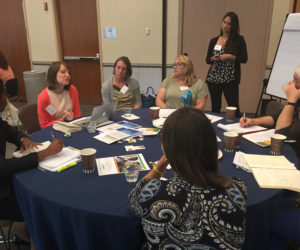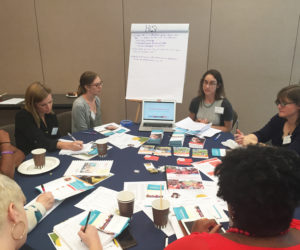Focus on the Right Issues When it Comes to Youth LARC Access
In 2015, the World Health Organization described World Contraception Day (WCD) as an annual event that “gives voice to the millions of people across the planet without access to family planning.”

Participants during round table discussions at the September 20 Consensus to Action meeting. Photo Credit: Marta Pirzadeh/FHI360.
In the week preceding WCD 2016, I participated in the quite timely Consensus to Action: Developing Solutions for Expanding Method Choice for Youth event in Washington, DC. The USAID-supported September 20 meeting – organized by Health Communication Capacity Collaborative (HC3) partner Population Services International along with Pathfinder International, Evidence to Action (E2A) and FHI360 – brought together long-acting reversible contraceptive and permanent method (LARC/PM) Community of Practice (CoP) members and supporters. The meeting focused on how professionals, organizations and donors can amplify the voices of the estimated 33 million young women in low- and middle-income countries who have an unmet need for contraception.
The event represented a next step to the 2015 Global Consensus Statement for Expanding Contraceptive Choice for Adolescents and Youth to Include Long-Acting Reversible Contraception – a declaration that Johns Hopkins Center for Communication Programs (CCP), where HC3 is based, is proud to endorse on this WCD.

HC3’s Erin Portilllo shares the project’s adaptable LARC materials during a round table, small-group presentation. Photo Credit: Marta Pirzadeh/FHI360.
The meeting’s approximately 60 attendees focused on learning, exchange and finding actionable solutions together around topics such as improving contraceptive counseling for youth, addressing provider values and perceptions, LARC demand creation and strengthening youth advocacy initiatives. HC3 was invited to present its adaptable LARC social and behavior change communication (SBCC) tools for providers and youth as one of six roundtable discussion topics.
For me, the meeting validated HC3’s work. The day’s opening remarks and each question I fielded confirmed that our LARC video, discussion guide, posters and brochures touch on just the right issues around youth LARC access – correcting misinformation about the IUD and implant, addressing provider bias and reinforcing important themes like dual protection and a young person’s right to choose their preferred contraceptive method from a range of choices that includes LARCs.
Participants were excited to see the tools were already adapted for use in Guatemala, and were planned for translation to French for use in the Democratic Republic of Congo and Mali. They had great ideas for adaptations hopefully to come: lower-literacy versions, rural youth versions and context-specific message revisions that prioritize married young women. Attendees offered additional dissemination ideas and got me thinking more concretely about how to share the materials’ adapted versions broadly to encourage direct collaboration between organizations, rather than have HC3 remain the materials’ primary gatekeeper.
HC3 continues to create and disseminate innovative SBCC tools to bring women – particularly youth – closer to the quality contraceptive counseling, care and options they deserve. We are following up with the 11 organizations/projects adapting the LARC materials for use in 12 countries (and welcoming more requests!), and will compile their stories on our website in the coming months. We are also taking our LARC materials one step further in a Youth Voices activity; later this year, we will work in Nigeria to create for-youth, by-youth videos to support young people’s understanding of and access to LARCs, and build youth capacity to continue such activities on their own, without HC3.
Looking forward, activities like Youth Voices and the enduring momentum behind the Consensus Statement can continue to strengthen youth’s self-advocacy on days like WCD and on all the days in-between.







Leave a Reply
Want to join the discussion?Feel free to contribute!